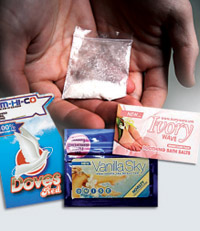‘Bath Salts’ Ingredient Worse than Cocaine, and 10 Times More Powerful
 Between 2010 and 2011, reports about the recreational drug commonly known as “bath salts” skyrocketed, and its use has been connected with a range of serious consequences including heart attack, liver failure, prolonged psychosis, suicide, violence, and even cannibalism. The drug, which is distinct from actual bath salts and sometimes goes by other names such as “plant food,” contains synthetic cathinones, which have effects that resemble those of amphetamines and cocaine. (Natural cathinone is derived from the plant Khat, which some cultures, particularly in the Horn of Africa and the Arabian Peninsula, have used socially for its euphoric effects when chewed.)
Between 2010 and 2011, reports about the recreational drug commonly known as “bath salts” skyrocketed, and its use has been connected with a range of serious consequences including heart attack, liver failure, prolonged psychosis, suicide, violence, and even cannibalism. The drug, which is distinct from actual bath salts and sometimes goes by other names such as “plant food,” contains synthetic cathinones, which have effects that resemble those of amphetamines and cocaine. (Natural cathinone is derived from the plant Khat, which some cultures, particularly in the Horn of Africa and the Arabian Peninsula, have used socially for its euphoric effects when chewed.)
Synthetic cathinones are not well understood, but a few studies published in the journal Neuropsychopharmacology this year provided some preliminary findings. The most common synthetic cathinone found in the blood and urine of patients admitted to emergency rooms in the US after taking bath salts is 3,4-methylenedioxypyrovalerone, or MDPV.
In a study of rats by Baumann et al., MDPV was found to have a strong blocking effect on uptake of the neurotransmitters dopamine and norepinephrine, while having only weak effects on uptake of serotonin. MDPV’s ability to inhibit the clearance of dopamine from cells is similar to cocaine’s actions, but MDPV is much more potent and effective at this. MDPV was also 10 times more potent than cocaine at producing physical symptoms in the rats, such as motor activation, tachycardia (irregular heart beat), and hypertension (high blood pressure).
Another study of rats by Fantegrossi et al. found that rats that received MDPV experienced motor stimulation that was potentiated by being in a warm environment. When the rats received relatively high doses in this environment, they engaged in profound stereotypy (repetitive movement) and self-injurious behavior such as skin-picking or chest-biting. This study also found similarities in the internal effects of MDPV and MDMA (ecstasy) and methamphetamine.

